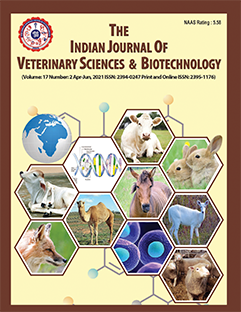Ancylostoma Induced Acute Haemorrhagic Gastroenteritis in a Male Adult Kanni Dog: An Uncommon Incidence
DOI:
https://doi.org/10.48165/ijvsbt.21.4.39Keywords:
Ancylostoma, caninum, canine, hookworm, diseaseAbstract
Ancylostoma caninum is the major cause of canine hookworm disease in most tropical and subtropical regions of the world and anaemia is the main pathological effect caused by blood sucking activity of the worms (Umeakuana et al., 2020). The disease is more often seen in young puppies or dogs under one year of age, by transmammary route of infection and adult dogs are mostly asymptomatic owing to their acquired immunity. Nevertheless, the dog may show iron deficiency and develop a microcytic hypochromic anaemia. Severe anaemia is commonly encountered in puppies and could be successfully treated by appropriate therapy, which includes blood transfusion (Jasmin et al. 2020). Hence, severe anaemia requires fecal examination and presence of many eggs in feces is suggestive of acute ancylostomosis, though clinical signs could be observed during the prepatent phase itself (Lefkaditis, 2001). This document reports an unusual case of ancylostoma induced acute haemorrhagic gastroenteritis and its management in an adult male Kanni dog.
Downloads
References
Aziz, P.R., Marodia, S., & Meena, S. (2020). Hookworm infection in a dog – A case report. The Haryana Veterinarian, 59(2), 283–284.
Bilic, P., Kules, J., Rafaj, R., & Mrljak, V. (2018). Canine babesiosis: Where do we stand? Acta Veterinaria, 68, 127–160.
Helm, J., & Knottenbelt, C. (2010). Blood transfusions in dogs and cats: Indications. In Practice, 32, 184–189.
Jasmin, R., Balagangatharathilagar, M., Edith, R., & Prathaban, S. (2020). Acute anaemia induced by ancylostomosis in a puppy and its successful therapeutic management – A case report. International Journal of Current Microbiology and Applied Sciences, 9(5), 1337–1340.
Lefkaditis, M. (2001). Ancylostomiasis in dogs. Scientia Parasitologica, 1, 15–22.
Mia, M.M., & Hasan, M. (2021). Update on canine parvovirus infection: A review from the literature. Veterinary Sciences: Research and Reviews, 7(2), 92–100.
Rao, N., Sadhu, D.B., Shah, A.I., Parmar, J.J., & Patel, D.M. (2021). Ascites associated with ancylostomiasis in dogs. The Indian Journal of Veterinary Science and Biotechnology, 17(2), 110–112.
Sainz, A., Roura, X., Miro, G., Estrada-Peña, A., Koh, B., Harrus, A., & Solano-Gallego, L. (2015). Guideline for veterinary practitioners on canine ehrlichiosis and anaplasmosis in Europe. Parasites & Vectors, 8, 75.
Sayed-Ahmed, M.Z., Elbaz, E., Younis, E., & Khodier, M. (2021). Canine parvovirus infection in dogs: Prevalence and associated risk factors in Egypt. World Veterinary Journal, 10(4), 571–577.
Sivakumar, M., Yogeshpriya, S., Saravanan, M., Arulkumar, T., Krishnakumar, S., Jayalakshmi, K., Veeraselvam, M., & Selvaraj, P. (2017). Concurrent infection of toxocariasis and ancylostomiasis in a puppy and its therapeutic management: A case report. Journal of Entomology and Zoology Studies, 5(4), 1289–1292.
Umeakuana, P.U., Idika, I.K., Kolade, O.A., Uchendu, G.O., Chukwudi, I.C., Kanu, E.C., Ogbonna, G.N., Ede, R.O., Nnaji, F.N., & Ugwu, G.N. (2020). Uncommon manifestation and the treatment outcome of ancylostomosis in a 4-month-old Caucasian dog: A case report. Annals of Short Reports, 3, 1056.
Downloads
Published
Issue
Section
License
Copyright (c) 2025 Indian Journal of Veterinary Sciences and Biotechnology

This work is licensed under a Creative Commons Attribution-NonCommercial-NoDerivatives 4.0 International License.




